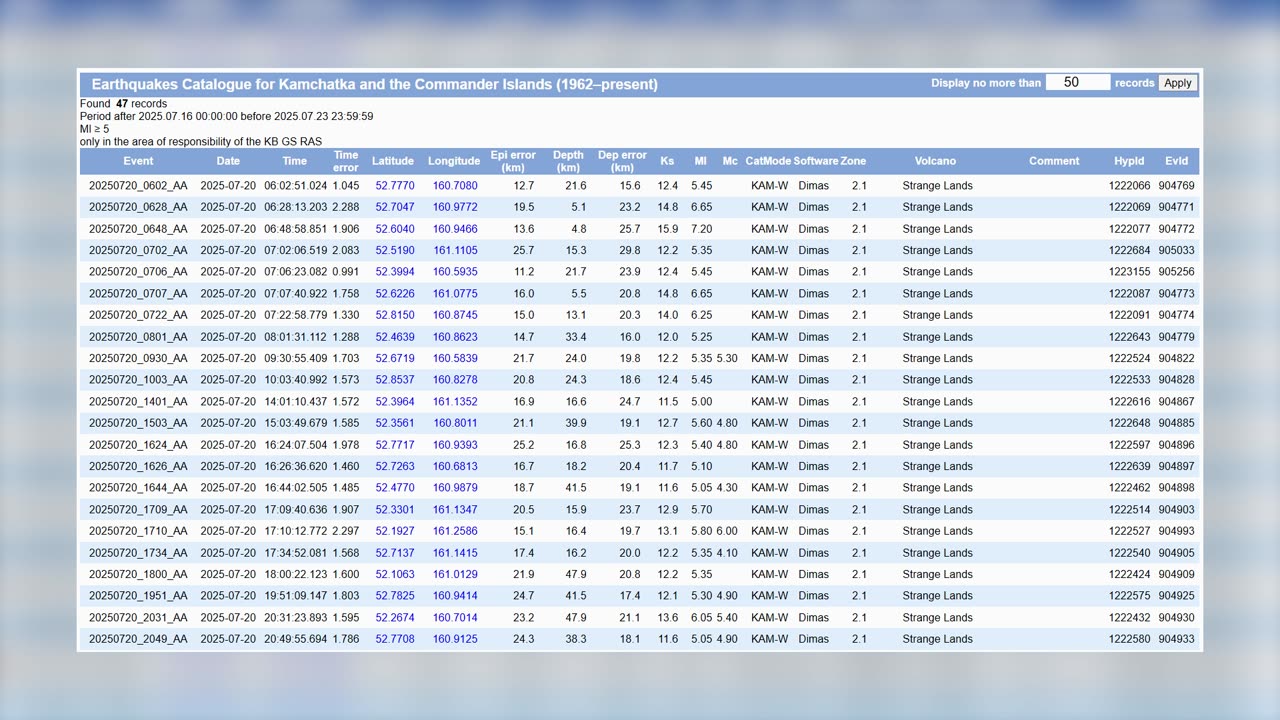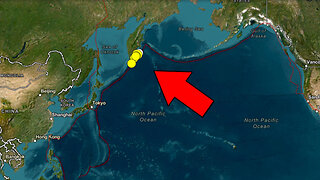Premium Only Content

Russia’s Kamchatka Peninsula Rattled by 7.6 Quake and 1,000+ Aftershocks
On July 20, a series of powerful earthquakes struck the Kamchatka Peninsula in Russia, beginning at 6:02 PM local time. The epicenters were located in the Pacific Ocean, at distances ranging from approximately 45 to 130 miles from the city of Petropavlovsk-Kamchatsky.
Within less than an hour, four earthquakes with magnitudes greater than 6 were recorded. The strongest quake reached a magnitude of 7.6.
Inside homes, furniture shook, dishes rattled, and items fell from store shelves. Alarmed residents rushed into the streets. Many were too frightened to return to their apartments and chose instead to spend the night at their dachas in the countryside.
Seismic tremors were felt across several populated areas, including the capital of Kamchatka Krai. During an inspection of public facilities, damage was discovered in the ceiling structure of a city children's clinic. According to experts, the cracks did not pose any threat to visitors, so the facility continued operating as usual.
Shortly after the initial shocks, the Ministry of Emergency Situations issued a tsunami warning and urged residents to move away from the coast and head to higher ground. However, by around 10:00 PM local time, the warning was lifted.
The earthquake triggered a strong series of aftershocks. Over the next three days, the region experienced roughly one thousand subsequent tremors, the most powerful of which reached a magnitude of 6.7. Among them, forty-seven aftershocks registered magnitudes of five or higher.
Not long ago, an earthquake of magnitude 5 would have made international headlines. Today, however, such events occur almost daily around the world and are no longer perceived as extraordinary — many go unreported altogether. This is perhaps the clearest evidence of the vast and largely unnoticed increase in global seismic activity.
Scientists from ALLATRA have already identified the cause behind the activation of Earth's geodynamic system, issued forecasts for an increase in earthquakes in the coming years, and — most importantly — proposed specific technological solutions to stabilize the situation.
-
 7:10
7:10
AllatRa TV
9 days agoKamchatka in Turmoil: 7.8 Quake, 47 Aftershocks, and Volcano Eruption
961 -
 5:17
5:17
Buddy Brown
1 day ago $0.57 earnedSomething BIBLICAL is Happening with the Earth's FREQUENCY! | Buddy Brown
7553 -
![[Ep 760] Schumer’s Shutdown & Sombrero-Gate | Obama Library, Tides Foundation, & Terrorists](https://1a-1791.com/video/fwe2/fa/s8/1/4/f/5/m/4f5mz.0kob-small-Ep-760-Schumers-Shutdown-an.jpg) UPCOMING
UPCOMING
The Nunn Report - w/ Dan Nunn
56 minutes ago[Ep 760] Schumer’s Shutdown & Sombrero-Gate | Obama Library, Tides Foundation, & Terrorists
301 -
 UPCOMING
UPCOMING
Film Threat
19 hours agoBATTLING COMMENTS ABOUT ONE BATTLE AFTER ANOTHER: HOLLYWOOD IS AT WAR | Hollywood on the Rocks
448 -
 LIVE
LIVE
The HotSeat
21 minutes agoPope Blesses a Hunk of Ice + The Govt is SHUTDOWN!!!
259 watching -
 3:12:38
3:12:38
Right Side Broadcasting Network
6 hours agoLIVE REPLAY: White House Press Secretary Karoline Leavitt Holds a Press Briefing - 10/1/25
97.6K53 -
 1:20:12
1:20:12
Russell Brand
4 hours agoFrank Turek on Charlie Kirk, Faith & Today’s Battle for Truth - SF643
105K42 -
 LIVE
LIVE
Jeff Ahern
1 hour agoNever Woke Wednesday with Jeff Ahern
174 watching -
 32:22
32:22
ArturRehi
2 hours agoDrone Wall, Blackouts, Assassinations — Russia Under Pressure
4K2 -
 1:59:29
1:59:29
The Charlie Kirk Show
3 hours agoShut It Down + End the ADL + The Baddest Bunny | Tim Pool | 10.1.2025
201K98